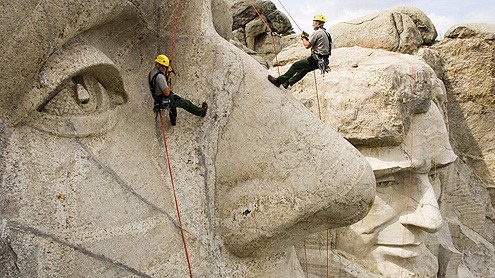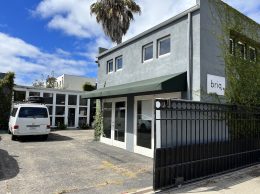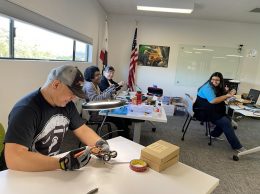Hanging tight: Employee-owned firm equips search and rescue teams
IN THIS ARTICLE
- Features Topic
- Marlize van Romburgh Author
By Marlize van Romburgh Friday, January 13th, 2012

Santa Barbara-based CMC Rescue manufactures harnesses, ropes and hardware for everything from search and rescue operations to rope access on Mount Rushmore. The firm became 100 percent employee-owned recently through a stock ownership plan. (courtesy photo)
When he founded CMC Rescue, Jim Frank created an entire industry of search and rescue equipment that didn’t exist before 1978.
Today, the Santa Barbara entrepreneur is handing the thriving business off to the people who helped him build it over more than three decades: His employees.
CMC Rescue makes and sells specialized harnesses, straps, bags and other equipment that fire departments, search-and-rescue organizations and the military use in emergency rescue situations.
The company has about 60 employees and a factory in Santa Barbara, where it makes equipment that’s sold around the U.S. and exported to China, South America, Australia and Europe.
“We’re very proud to be able to say we make it in Santa Barbara and export to China,” CFO Beth Henry told the Business Times.
It’s a niche business, but the 34-year-old company is still growing by leaps and bounds: It currently has 15 open positions after adding five more people toward the end of 2011. Sales last year clocked in at record highs, Henry said.
And over the past two years, the thriving business has become 100 percent employee-owned.
Frank founded the company because he saw an unmet demand from the search and rescue organizations he volunteered with for specialized equipment. “Jim started making the stuff quite literally because he couldn’t buy it anywhere in this country,” said John McKently, who’s been running the training school at CMC for 18 years and has been a volunteer with the Los Angeles County Sheriff’s Department search-and-rescue team for more than 30 years.
But as Frank grew the company over three decades, there wasn’t an obvious succession plan; he didn’t have a family member waiting in the wings to take over the company.
What he did have were dozens of employees who have been with the company for many, many years, and who are so passionate about search-and-rescue that they continue to volunteer hundreds of hours a year with the teams.
Frank had received numerous acquisition offers from interested buyers, Henry said, but ultimately didn’t want to sell his company to strangers. “The thing Jim liked the least is that once you sell your business, you don’t have much say as to how it’s run,” she said.
CMC’s founder has in recent years stepped away from day-to-day management of the company, but remains its chairman. His college friend and fellow engineer, Rich Phillips, has taken over CMC’s reins as CEO.
Phillips had an idea — a succession model he’d seen work at other firms. He suggested that Frank and the other two shareholders in the company consider what’s known as an Employee Share Ownership Plan, or ESOP. Through such a plan, employees receive equity in the company as part of their salaries. “It seemed like the only way that Jim could turn the company over to the people that had helped make it successful,” Henry said.
“[The plan] was a very, very generous thing to do because quite frankly he had the opportunity to take the money and run,” McKently said. “It’s good for the company in the long run, and it’s good for us a retirement benefit.”
Frank graduated with an aeronautical engineering degree from Cal Poly, San Luis Obispo, then went on to study law. In the ’70s, he became a search and rescue volunteer in Santa Barbara County — a passion that would continue for decades. As a mountain rescuer, he soon realized that no specialized equipment was available for search and rescue — most rescuers were getting by with firefighting and other equipment adapted for their own uses.
So Frank put his engineering background to use and started designing the equipment his team needed. As the company blossomed, he hired other search and rescue experts who could help develop and test the equipment and work with rescue teams who use it.
It’s a niche business, but for a long time CMC was the only company making that equipment. “There is competition that didn’t exist 30 years ago,” McKently, said. “ But you could say this whole industry didn’t exist 30 years ago.”
Setting up an ESOP
Converting to employee ownership is a complex process, and Henry cautioned that especially for a small- to medium-sized company, it can be costly. “ESOPs are a little tricky to put together. It’s a qualified retirement plan. You have to comply with a lot of IRS and employment regulations. You have to hire an attorney. It’s similar to setting up a 401(k) program,” she said.
Despite that, she said she couldn’t encourage the employee ownership model more. “Our employee-owners have really stepped up and embraced the ownership culture at CMC,” she said via email. “They absolutely get how their individual jobs connect to companywide success, and they are increasingly engaged in all aspects of the business. We had record-breaking sales last year, despite the fact that our customers are primarily government funded and experiencing huge budget cuts.”
In an interview, Henry said that CMC now has an open-book policy with its employees — they’re privy to the financial statements and are encouraged to ask questions. “You have to share good news and bad news and you have to get their opinions … This really pushed it down through the ranks to where our employees ask questions and they’re encourage to make suggestions,” she said. “Suddenly we’ve got employees running around the place turning lights off.”











